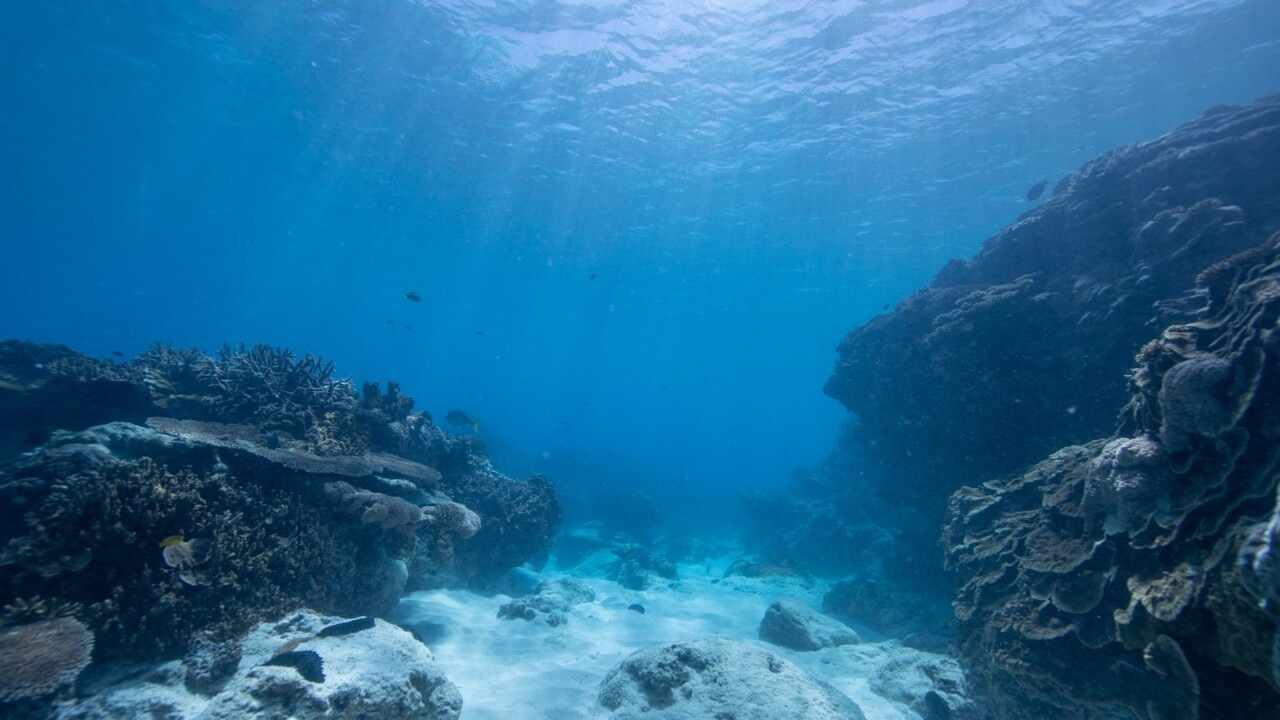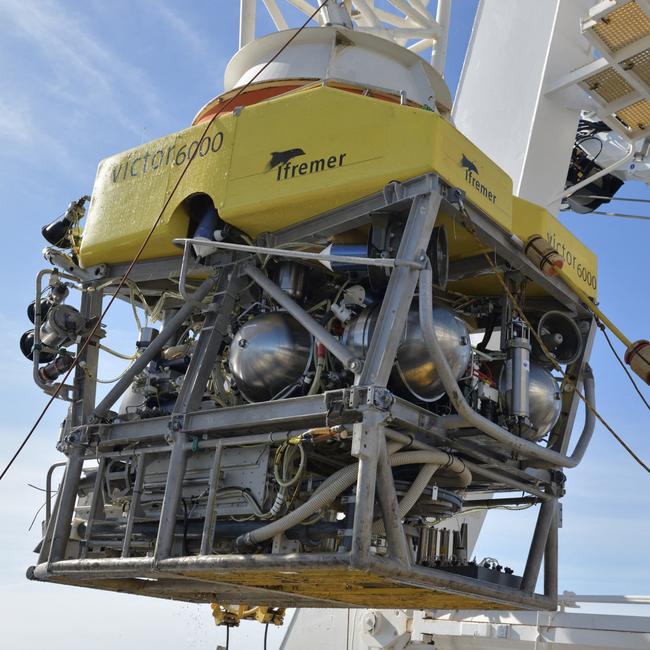How search teams have scrambled to find the Titan submersible vessel
Officials race to locate the tourist submarine with a fleet of ships and robot subs joining the mission to find its five passengers before their oxygen runs out tonight.

Officials were racing against time to find five people who were aboard OceanGate Expeditions’ submersible, which went missing Sunday, shortly after descending to tour the wreckage of the Titanic.
The Atalante, a French ship, is expected to reach the area Wednesday night (local time), armed with a remotely operated vehicle known as Victor that can go where most rescuers cannot. The Victor 6000 autonomous robot is capable of descending to a depth of 20,000 feet, far deeper than the wreckage of the Titanic, according to the French Institute for Research and Exploitation of Sea.
A team of experts who can operate the robot left the Southern French city of Toulon around midday on Tuesday and are expected to board the ship Wednesday evening or Thursday morning, allowing the Victor 6000 to join the rescue effort.
The U.S. used a remotely operated vehicle (ROV) in salvage operations at the depth of the Titanic to locate and recover a crashed jet fighter from a depth of 12,400 feet in the South China Sea last year. The U.S. military used the ROV to attach rigging around pieces of the aircraft and connect it to a lifting hook that was lowered from a crane on the rescue ship.
Captain Jamie Frederick from the U.S. Coast Guard said that the surface search area is two times the size of Connecticut and that they have covered 7,600 square miles so far. The Titanic wreck is about 400 miles off the coast of Newfoundland and 900 miles off the coast of Massachusetts.
The U.S. Coast Guard said Canadian aircraft had detected underwater noises in the search. Crews have sent two remote-operated vehicles and a surface vessel toward the area the sounds came from, the Coast Guard said Wednesday morning.
Rear Adm. John Mauger, who is leading the search, said the Coast Guard had brought in technical experts, dropped sonar buoys to listen for underwater noise and asked other government bodies for aid “to really better understand what an undersea search and rescue effort would look like.”

The Coast Guard has deployed two C-130 aircraft and sonar buoys that can listen to a depth of 13,000 feet. The New York National Guard has sent a third C-130, the Canadian Coast Guard added a fourth, along with a P-8 Poseidon aircraft that has underwater detection capabilities.
Mauger said it is also relying on ships that were sailing nearby and OceanGate’s command ship — the Polar Prince — for help.
Rescuers have shifted their search for a missing submersible to an area where Canadian aircraft detected banging noises underwater, officials said Wednesday, as the clock ticked down in the race to find the crew that was headed to the Titanic shipwreck.

The U.S. Coast Guard said Navy analysts haven’t determined the source of the noises, which were heard on Tuesday and on Wednesday morning.
“We don’t know what they are, to be frank with you,” Capt. Jamie Frederick of the First Coast Guard District said Wednesday afternoon.
The Coast Guard said there are five surface assets and two remotely operated vehicles currently searching in the area the noises came from, with more arriving in the coming day.
“Although the ROV searches have yielded negative results, they continue,” Frederick said.
The banging sounds offered a dash of hope during an extensive search in a remote part of the North Atlantic. The world has watched as international crews have combed an area twice the size of Connecticut for a roughly 22-foot-long submersible that disappeared Sunday on a trip to the Titanic shipwreck, which is more than 2 miles underwater. The search area has expanded by the hour because of weather conditions and ocean currents, Frederick said.
The people on board the submersible include a prominent British-Pakistani businessman and his son, a wealthy British aviator and a French dive expert who is considered one of the world’s foremost authorities on the Titanic wreck.
The emergency oxygen on the submersible, called the Titan, was expected to run out on Thursday morning, according to a timeline laid out Tuesday by the Coast Guard. Frederick said that the oxygen supply was one of many data points that rescue crews were considering. He said there were limited rations on board the vessel. The Coast Guard didn’t immediately respond to a request for an updated oxygen estimate.
“There’s an enormous complexity associated with this case due to the location being so far offshore and the coordination between multiple agencies and nations,” Frederick said.
International agencies have sent equipment to the site where they believe the Titan is located, about 900 miles off Cape Cod, Mass. The vessel is owned and operated by a little-known company called OceanGate Expeditions, whose founder and chief executive is on board, and has put a spotlight on a niche and generally unregulated part of the tourism industry, typically for wealthy people.
“This is a search and rescue mission, 100%,” Frederick said, adding: “We’ll continue to put every available asset that we have in an effort to find the Titan and the crew members.”

It is possible the crew has already died from a fire, flood or other disaster, naval and marine-robotics experts said. If they are still alive, they could die from oxygen loss once the vessel’s carbon-dioxide scrubbers, which clean the gas from the atmosphere, fail or become saturated.
The carbon-dioxide increases in the atmosphere at that point would result in shortness of breath, headaches, tiredness, paranoia and seizures, and eventually death, said Mike Tipton, professor of human and applied physiology at the extreme environments laboratory at the University of Portsmouth in the U.K.
Time is running short to locate and resurface the vessel. It could take days to retrieve remotely operated vehicles that would be able to lift the Titan to the surface, naval and marine-robotics experts said.
The submersible could also be retrieved by potentially using a steel cable or inflated balloons, said Henry Hargrove, a senior technical analyst at Rand Corporation, who served on U.S. submarines for 11 years.Frederick has said the Coast Guard set up a unified command together with the U.S. Navy, the Canadian Coast Guard and OceanGate to widen the search and unify expertise and specialized equipment.

The Explorers Club, an organization dedicated to scientific exploration, said OceanGate had sought assistance from Magellan, a deep-sea mapping and investigation company based in the U.K., to use its deep-sea remotely operated vehicle to help find the submersible. Magellan’s vehicle has the capacity to go far deeper than the ones currently on site, Explorers Club said.Frederick said Wednesday that his agency was making decisions about which offers of assistance to accept based on how quickly the equipment could arrive and how useful it would be. OceanGate declined to comment.Horizon Maritime, a marine-service company in Canada whose fleet includes the Polar Prince vessel that carried the Titan submersible to its launching point, said it had 17 crew members aboard the Polar Prince, plus one other ship, aiding search efforts.
The Wall Street Journal






To join the conversation, please log in. Don't have an account? Register
Join the conversation, you are commenting as Logout